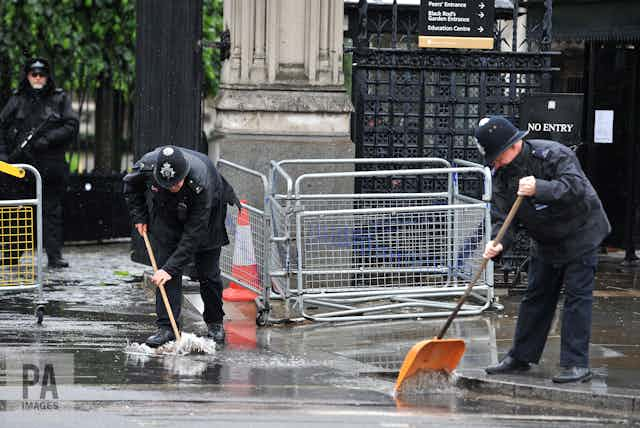Earlier this year, an unusual weather pattern dubbed the Beast from the East covered much of Britain in heavy snow. But once the beast had passed, things soon returned to normal and, at the beginning of March, the temperature in London jumped by more than 10°C in just two days. Water pipes that had been frozen solid quickly thawed, and the sudden flood soon overwhelmed the capital’s creaky infrastructure, causing many pipes to burst. More than 20,000 homes in the city were left without water, and residents had to queue for handouts.

Could this become a common sight in future? The UK’s Environment Agency certainly thinks so, as it warns in a new report that England could suffer major water shortages by 2030 and that London is particularly at risk. The BBC agrees, placing London on its recent list of 11 cities most likely to run out of drinking water along with the likes of Cape Town, where an ongoing water crisis has caused social and economic disruption.
London is unlikely to experience such shortages this summer. It is the winter (not the summer) weather that determines whether or not the city runs out of water, and winter 2017/18 had plenty of rain. But what happens after a dry winter?
At Oxford’s Environmental Change Institute, colleagues and I have addressed the question of how to prevent London from becoming the next Cape Town. Our research shows that if no action is taken the city is indeed set to experience more frequent and severe water shortages in the future. This is mainly down to population growth, but climate change complicates things further as it will mean more frequent and intense droughts.
In agreement with the plans developed by Thames Water – the private utility responsible for providing water and sewage services for most Londoners – our research shows that aggressive demand management to reduce consumption and losses in the distribution system (called leakage) is a priority to be implemented immediately. But reducing leaks from London’s old water pipes is not an easy task.

Over the past few years, Thames Water has missed its leakage reduction targets. In 2017, the failure to meet these leakage reduction commitments cost the water company an £8.55m fine from the water regulator, only a fraction of the £100m the water company paid investors in dividends in the same year. Recognising the scale of investment and effort required, the company now says it is directing all its resources towards upgrades and maintenance rather than dividends.
But there are limits to what can be achieved just by fixing leaky pipes or getting people to water their lawns less often. Though such measures are useful, they will not safeguard London’s water supplies against the more extreme combinations of growth and climate change.
Water recycling
Instead, the city’s water managers have been thinking about innovative ways to augment supplies. Potential solutions include building new reservoirs or transferring water from other parts of the country. More radically, London could start recycling its wastewater back into the river Thames. This would involve advanced treatment of wastewater from a sewage treatment works that is then returned to the Thames river downstream of an abstraction point. This would allow for more abstraction upstream, without compromising the environment’s water needs.
How should London choose between these different alternatives? The city needs something that’s not too expensive, that keeps residents happy with the price, taste and appearance of the water, while also reducing the risk of the taps running dry.
My colleagues and I looked at the various options – new reservoirs, water transfers, desalination and recycling – and the model we developed shows that the recycling of treated wastewater back into the river makes most sense from an economic and risk reduction standpoint.
Water recycling works in Singapore, where water is reused time and again, thus closing the loop between supply and demand – an example of the circular economy.

Yet all this requires a change of thinking. Traditionally, investments in new pipes or reservoirs are based on estimates of future water availability and needs. These estimates are based on past observations, which means that water engineers look at how much rain there was in the past and then assume that there will be as much in the future. Typically, this results in infrastructure that delivers a secure supply of water at the lowest cost possible – under “normal” conditions.
However, the future will be significantly different from anything imagined when water supply systems were first built. We will have to leave more water in the rivers for aquatic ecosystems to thrive. We will have to deal with more erratic rainfall.
To prevent London from becoming the next Cape Town, individual residents will have to use water as wisely as possible. And their water managers will have to focus on what will work even in an era of significant climate change.

